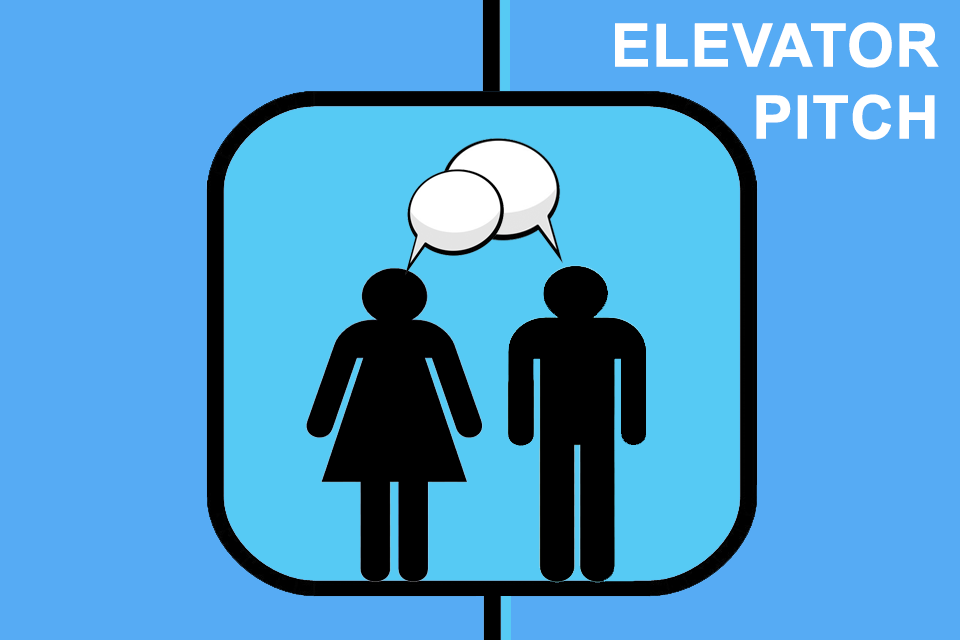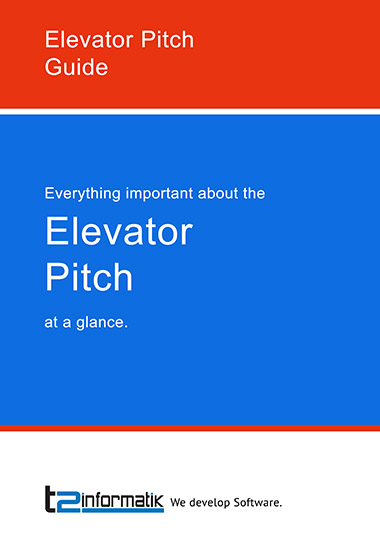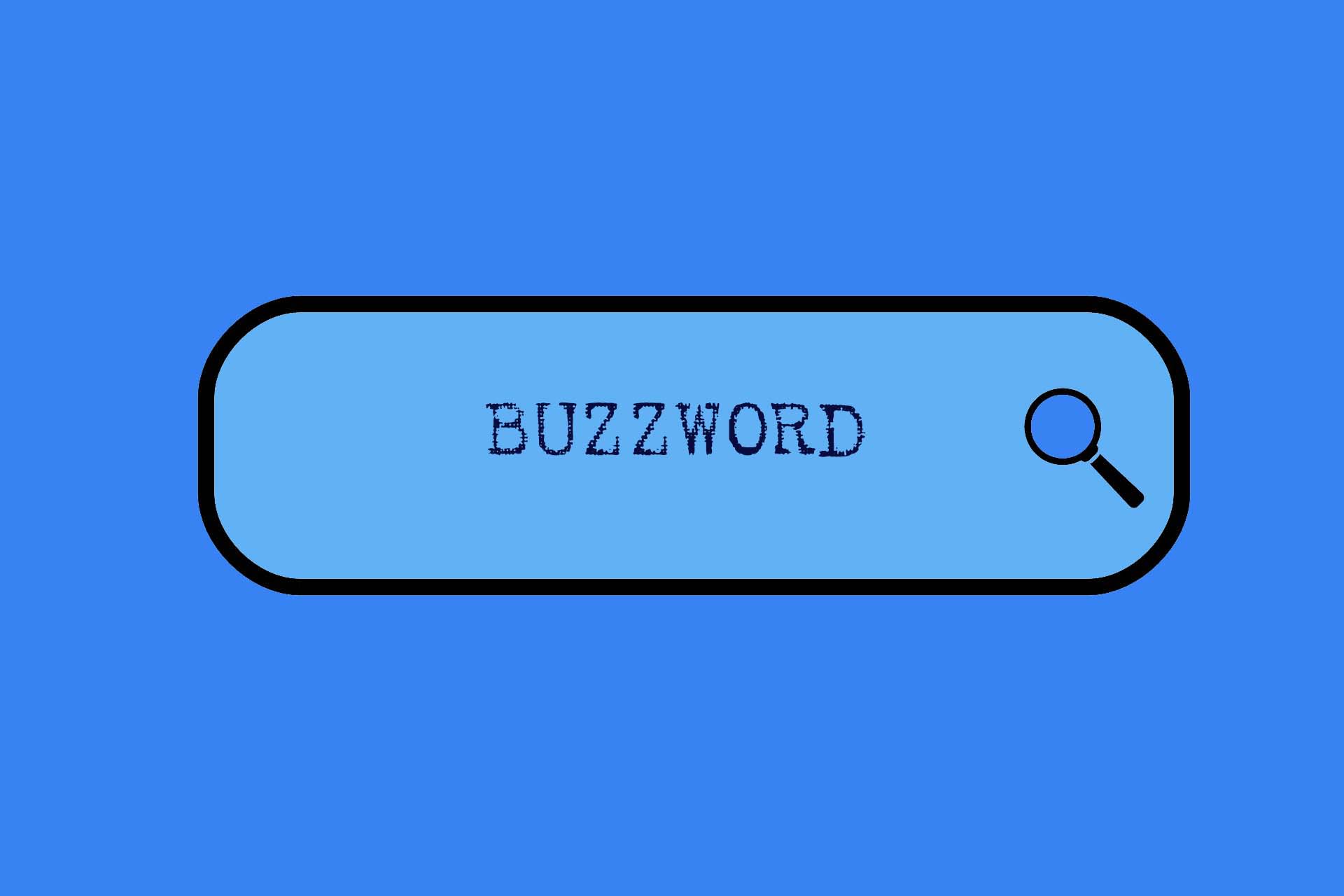What is an Elevator Pitch?
Table of contents: Definition – Situations and ares – Core elements – Example – Questions from the field – Download – Notes
Smartpedia: An elevator pitch is a concise verbal presentation of an idea that is promoted by name in an elevator to attract the interest of a decision maker.
Elevator pitch – the short presentation of an idea
An elevator pitch refers to the concise verbal presentation of an idea within a short period of time – the length of a ride in an elevator, as the name suggests. The aim is to promote
- an idea,
- a suggestion for improvement,
- a decision,
- a product or
- a service
and thus gain the interest of a decision-maker. [1]
Clarity about one’s own position, goal or idea is the prerequisite for a successful short presentation. This clarity becomes an advantage over all others who do not have the corresponding clarity or cannot convey it within a very short time. It helps to arouse interest, find fellow campaigners, outline positive perspectives and convey enthusiasm.
Alternative terms for Elevator Pitch are Elevator Speech and Elevator Statement.
Situations and areas of application for an elevator pitch
There are countless situations and places in which an elevator pitch and thus the delivery of an intended message is called for:
- Even though the lift is the namesake for pitching compressed messages, in reality an elevator pitch rarely takes place in lifts. However, should the opportunity arise to promote an idea in the lift, in the corridor, in the coffee kitchen, in the canteen or at a parking machine, it is important to seize the chance.
- When it comes to telephoning, the message is also: “Keep it short and simple.” So: it’s all about the idea, the problem, the solution and the benefits.
Far from typical phrases, it is a good idea in job interviews to formulate yourself, your attitudes, motives or goals in a concise manner. - Perhaps you are familiar with speeches at trade fairs or conferences that begin with “May I interrupt you for a moment?” or “May I ask you why you are here at the trade fair?”. To use the image of the lift: it has already reached its floor without the questioner having even the slightest chance of a successful pitch. A pity, really.
- There are events such as Bar Camps or Open Spaces where speakers are given the opportunity to promote themselves and their contribution for one minute at the beginning of the event: The aim is to motivate the audience to attend the lecture, e.g. because they can take something away with them (knowledge, news, an idea, etc.).
What these examples have in common is that communication preparation is possible in the run-up to a contact, regardless of whether the contact is made or not. Whether the contact is made or not can be a coincidence, but whether it is successful is not a coincidence. The better the preparation, the higher the chance of success.
Just as there are countless situations and places for an Elevator Pitch, there can be numerous areas of application:
- In the sales pitch, a salesperson tries to advertise himself, his product or his service within the shortest possible time.
- In a start-up pitch, business ideas are presented to potential investors. This usually happens in an orchestrated setting with various start-up representatives and one or more investors.
- In idea management or in the course of an ideation,
- in project management, when advertising for future projects,
- in project markets, when individual projects are looking for collaborators (project markets can be a characteristic of agile organisations),
- in development, when sales people promote the implementation of features that offer important benefits to their customers,
and in marketing, when advertising budgets are allocated.
In reality, there are almost infinite uses for the Elevator Pitch. The producer pitches his idea to the director, the software developer inspires his colleagues with a groundbreaking technology, and colleagues from middle management are looking for comrades-in-arms for a company spin-off. The closer one “looks”, the more often the elevator pitch can be found in daily interaction. One thing remains clear: with good preparation, an idea can be presented succinctly.
Core elements for a successful elevator pitch
A successful elevator pitch consists of several core elements that together convey a convincing and clear message. These elements ensure that the listener quickly grasps the essential information, develops interest and ideally considers taking action.
The first core element is a clear definition of the problem or demand. An effective pitch often begins by stating the problem to be solved or the demand that the product or service fulfils. It is important that the listener recognises the problem immediately and can identify with it. A concise formulation of the problem creates the basis for the following statements and attracts attention.
This is followed by the presentation of the solution, which represents the core offer of the pitch. This solution should be described briefly and concisely, focusing on how it effectively solves the previously stated problem or fulfils the demand. A good pitch emphasises the uniqueness of the solution and why it stands out from other offerings on the market.
The third element is the presentation of the benefits. This is where the specific added value the solution offers the listener or their target group is explained. The aim is to present the benefit clearly and comprehensibly – be it in the form of time savings, cost reduction, increased efficiency or other relevant advantages. The benefit should be formulated in such a way that it directly addresses the needs of the listener.
Another key element is the proof of credibility. This section of the pitch emphasises the credibility of the solution through concrete examples, figures, successes or references. Whether these are success stories, customer testimonials or relevant key figures, the aim is to convince the listener that the solution presented not only works in theory, but has already achieved success in practice.
Finally, the call-to-action is an indispensable element of a successful elevator pitch. A pitch should always end with a clear call to action, be it a suggestion for a follow-up discussion, a meeting, a product demonstration or obtaining feedback. The call-to-action gives the listener a clear direction on how to proceed after the pitch and reinforces the motivation to respond to the offer.
To summarise, a successful elevator pitch consists of a concise definition of the problem, the presentation of a clear solution, an emphasis on the benefits, proof of credibility and a concrete call-to-action. Together, these elements create a logical, convincing and memorable pitch that arouses the listener’s interest and moves them to take action.
Elevator pitch example
“Hello Mr. Meyer (CEO), Jennifer Mueller my name. I work in product development and have dealt with the problem X that our company has already had for 12 months. I have a great idea of how we can not only solve the problem at short notice, but also win new customers at the same time. We do it like Apple, but 50% cheaper. In just 10 minutes, I’ll outline the solution and the big advantage. Can you take these 10 minutes today?”
If there is a given time frame, e.g. for a presentation or a scheduled meeting, the following information could / should be transported (at least in parts):
- Entry: Who are you?
- Problem: Which problem do you solve?
- Solution: How do you solve the problem? Gladly argue with examples and pictures: “Like Google, only with language on the TV.”
- Advantage: What is the advantage of the solution? Is it a monetary advantage, does the image increase, are delivery times reduced, etc? Does the advantage express itself in ONE key figure?
- Time: Why is now the right time for the solution?
If the solution is a new product / a new market for the company, further information can be important:
- Market: Which market is it? Where is it, how big is it, which market shares and sales can be achieved in which time periods? As with the elevator pitch, it is advisable not to promise too much but to communicate a serious, well-founded position.
- Business model: How does the business model work to address the market with the new solution?
- Investment: How big is the investment to turn the idea into a product and to achieve market shares and sales?
And last but not least:
- Summary: A catchy message that summarises the whole in as few words as possible.
By the way: In 30 seconds, about 75 words can be spoken. With the Elevator Pitch, in addition to the information mentioned, the actual idea and the presentation, one thing is important: “Keep it short and sweet!”
Questions from the field
Here you will find some questions and answers from the field:
How long does an elevator pitch take?
The duration of an elevator pitch varies and cannot be determined exactly, as it depends heavily on the respective situation (see also Situations and areas of application…). Some publications mention a duration of 30 seconds to 2 minutes, others speak of 45 or 60 seconds. But which lift really runs for 60 seconds or longer?
Such a duration is not set in stone and should therefore rather be understood as an indication of the opportunity to arouse interest in a product, service or idea in a very short period of time. The aim is to arouse the interest of the other person in the shortest possible time and, if necessary, to initiate a further conversation. The decisive factor is therefore not so much the exact duration, but how effectively you get your message across.
What tips help with the elevator pitch?
Even if the time is short, there are various pieces of information that could / should be part of an Elevator Pitch. Of course, the content and scope depends on the actual time available. Since this is usually unclear, in practice exactly one piece of information can be conveyed. This information must attract the attention and interest of the target person. At that moment. That means it must be catchy and memorable, and ideally contain a promise. A promise of what the idea, service or product will make better in the future.
Here are some important tips on the Elevator Pitch:
- A good idea is a prerequisite for a successful pitch, but excellent preparation is equally important. Practice the pitch to ensure it goes smoothly and with confidence. Adjust and refine it based on feedback and interactions in practice, as this is the only way to make the short presentation perfect.
- What good is a good idea and excellent preparation if you don’t have an opportunity for the short presentation. So create suitable opportunities. See when you can meet the target person in the coffee kitchen or in the car park to place your idea.
- Start with a hook: Begin your presentation with a compelling statement or question that grabs the listener’s attention.
- Clearly define the problem: Clearly articulate the problem or challenge that your product, service or idea solves. This helps the target person understand the relevance and value of your approach.
- Highlight your unique selling point: Stand out from the competition by emphasising what makes your idea stand out. Clearly communicate the unique benefits or advantages your solution offers.
- Use concrete examples or stories to illustrate the impact and effectiveness of your solution. This will make your short presentation comprehensible and memorable.
And last but not least conclude your presentation with a clear call to action so that the target person takes the next step; whether it is making an appointment, trying your product or visiting your website. And make it easy for the target person to take the next step.
What are typical elevator pitch mistakes?
Typical mistakes are often made during the elevator pitch, which can significantly impair the success of the presentation. One of the most common mistakes is that the pitch becomes too lengthy. Many people tend to get lost in the details and lose sight of the essentials. However, an elevator pitch should be short and concise, as the listener’s attention quickly wanes. It is important to focus on the core message and avoid unnecessary information.
Another typical mistake is an unclear message. If the listener does not immediately understand what the pitch is about or what problem is to be solved, the point of the pitch is lost. The message must be simple, understandable and to the point. Avoid unnecessary jargon or complex explanations that could make the pitch confusing.
Failure to adapt to the audience is also a common stumbling block. A pitch that is not tailored to the specific interests and needs of the other party often misses the mark. It is crucial to adapt the pitch depending on the audience and to emphasise relevant aspects that are important to the person you are talking to.
Body language and demeanour should not be underestimated. Even the best words can lose their impact if the body language is unsure or inappropriate. A firm handshake, open eye contact and an upright posture convey self-confidence and support the spoken message. The tone of voice should also be clear and convincing in order to inspire confidence.
Flexibility is another important aspect that is often neglected. Whilst a well-planned pitch is essential, you should be prepared to respond spontaneously to questions or comments from the other person. A rigid, short presentation that does not allow for any interaction comes across as unnatural and can be off-putting.
After all, authenticity is crucial to the success of an elevator pitch. Listeners quickly notice if someone is just rattling off memorised sentences. A pitch should come across as authentic and reflect your conviction in what you are saying. Show passion for your idea and stay true to yourself.
To summarise, a successful elevator pitch can only succeed if it is clear and concise, the message is conveyed clearly and you adapt to your audience. Pay attention to your body language, remain flexible and, above all, authentic. If you take these points into account, you will avoid the typical mistakes and maximise your chances of convincing your counterpart.
How can sentence templates help with pitching?
Sentence templates are an effective tool to improve the structure and clarity of an elevator pitch. They provide a proven framework that ensures all essential information is presented concisely and logically. By using a sentence template, you can focus on making the content compelling without worrying too much about the wording or structure.
A typical sentence template for an elevator pitch could look like this:
- ‘Did you know that [target group] often struggles with the problem [problem]?’
- ‘Our solution, [product/service], helps solve this problem by [key benefit/solution].’
- ‘What makes us special is [unique feature/benefit].’
- ‘If you want to learn more about how we can help you, let’s schedule [next step, e.g. a meeting].’
Or phrased slightly differently:
‘For [target audience], with [problem or need], our product delivers [solution], with the promise that [key feature]. Unlike [main competitor], it is [unique selling point, competitive advantage]. If interested [call-to-action].’
The use of such sentence templates not only makes the pitch clearer and more structured, but also easier to understand. The templates offer a balance between flexibility and structure: you can adapt the pitch to the respective target group without losing sight of the basic principles.
Sentence templates are particularly helpful for many people who find it difficult to formulate their ideas briefly and concisely. They prevent you from getting lost in the details and ensure that your pitch gets to the point. Ultimately, the use of sentence templates helps to create more convincing and memorable elevator pitches that arouse the other person’s interest and convey a clear message.
Which marketing concepts offer structuring aids for a successful elevator pitch?
Marketing concepts such as AIDA (Attention, Interest, Desire, Action) and PPPP (Picture, Promise, Prove, Push) offer valuable structuring approaches that can be directly applied to the creation of a convincing elevator pitch. These concepts help to develop a clear and convincing message that effectively appeals to the listener and motivates them to take action.
The AIDA model, one of the best-known concepts in marketing, describes the phases that a customer goes through before making a decision. These phases can also be applied to an elevator pitch:
- Attention: At the beginning of the pitch, you need to get the listener’s attention. This can be done with a surprising statement, an interesting question or a powerful assertion: ‘Did you know that 80% of companies fail because they don’t understand their target group properly?’
- Interest: After attracting attention, the other person’s interest should be further deepened. This involves explaining why the problem is relevant and how your solution can contribute to it: ‘Our platform analyses customer behaviour and helps companies to develop targeted marketing strategies.’
- Desire (craving): In this step, the desire to learn more about the presented solution should be awakened. You emphasise the unique benefits of your own solution: ‘Our solution has already helped 50 companies increase their conversion rate by 30 %.’
- Action (action): The pitch should end with a clear call-to-action that suggests the next step: ‘Let’s schedule a quick meeting so I can show you how we can help your business too.’
The PPPP model is another effective concept that can be used for an elevator pitch. It helps to make the pitch emotional and convincing:
- Picture (picture): At the beginning, you paint a picture of the problem or situation to arouse interest: ‘Imagine your team could be twice as productive with no extra effort.’
- Promise: This is where you promise how the product or service being presented can solve the problem: ‘Our software automates your daily tasks, freeing up more time for the projects that really matter.’
- Prove: Back up your promise with evidence, such as references, studies or concrete results: ‘Over 100 companies are already using our solution and report a 40% increase in efficiency.’
- Push (impetus): Finally, a push to action should be given, for example through an offer or a concrete proposal for the next step: ‘Why don’t we get together next week and see how we can optimise your processes?’
In addition to AIDA and PPPP, there are of course other concepts that offer support for the elevator pitch:
- PAS – in other words, Problem, Agitate, Solution. This approach is about identifying the customer’s problem, addressing the associated pain points and presenting a solution for these.
- IDCA – i.e. interest, desire, conviction, action. This approach addresses the interest and desire for a solution, the delivery of compelling arguments to support the value proposition and a strong call to action.
Taken together, each of these concepts helps to build a pitch logically and persuasively by ensuring that all key elements – from attention-grabbing to call to action – are considered.
Only those who are able to perform a good elevator pitch are able to sell a product successfully.
Notes:
If you like the article or would like to discuss it, please feel free to share it in your network. And if you have any comments, please do not hesitate to send us a message.
[1] “Pitch” or “pitching” are terms widely used in the agency and advertising industry. Agencies compete against each other to convince clients of their merits, an idea or a concept. In order to create the same conditions for all participants, the available time is usually defined in advance; an essential difference to a “real” lift pitch, where the available time is unclear, provided it is actually a joint lift ride. Other differences include presenting in a team, using presentation materials or demonstrating prototypes.
Here you will find a nice video example and a 9 step plan for a convincing Elevator Pitch (both in German).
And here you can find additional information from our t2informatik Blog:




